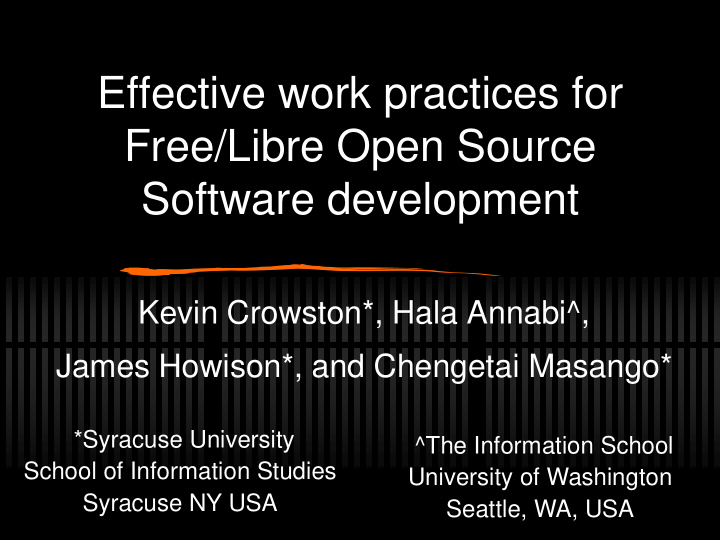



Effective work practices for Free/Libre Open Source Software development Kevin Crowston*, Hala Annabi^, James Howison*, and Chengetai Masango* *Syracuse University ^The Information School School of Information Studies University of Washington Syracuse NY USA Seattle, WA, USA
Overview of talk Interdisciplinary software engineering Study of work practices for OSS Research questions Theories Study design
Domain of software engineering
Software engineering and related disciplines Software Engineering Information Computer Management Systems Science Computer Engineering
What is FLOSS? FLOSS = Free/Libre Open Source Software Software distributed under license that allows inspection, modification and redistribution of the source code AKA free or libre software “Free as in speech” vs. “free as in beer” Examples: Linux, Apache, gcc, sendmail, X- windows, GNOME, GAIM, OpenOffice, etc. …as well as many lesser -known projects
Why FLOSS is interesting for this workshop Mostly developed by distributed teams of volunteers coordinated via the Internet Conway’s law: Structure of the software reflects the structure of the team that develops it Implies that distributed teams should have trouble creating integrated software Successful FLOSS teams somehow overcome problems of distributed software development
Overall research question What work practices make some FLOSS teams more effective than others? Issues What do we mean by effective? What practices should we look for?
Effectiveness: Success measures in IS DeLone & McLean (1992): System Use quality Difficult to observe, Organizational Individual impact impact especially for FLOSS Information User quality satisfaction Seddon (1997): system quality, information quality, perceived usefulness, user satisfaction, and IS use
Effectiveness II: Our success model User & Co-developers Contribution User Feedback System System System Creation Use Consequences • User-base • One-off event vs. • Developer Satisfaction “often and early” (developers are often • Downloads users) • Completion vs. • Meets development Progress of process goals • Number of developers
Effectiveness III: Hackman’s Team Effectiveness Model Organizational context A context that supports and reinforces competent task work, via: Group effectiveness Process criteria • Reward system • Task output acceptable to of effectiveness • Education system those who receive or • Level of effort brought to • Information system review it bear on the team task • Capability of members to • Amount of knowledge and work together in the future skill applied to task work is maintained or Group design • Appropriateness of the task strengthened A design that prompts and performance strategies • Members’ needs are more reinforces competent work used by the team satisfied than frustrated by on the task, via: the group experience • Structure of the task • Composition of the group • Group norms about performance processes Group synergy Material resources Assistance to the group by Sufficiency of material Coordination interacting in ways that: resources required to • Reduce process losses accomplish the task well and theory • Create synergistic process on time gains Collective mind
Practices of interest Coordination of task Social structures of communication and development Member recruitment Development of norms (e.g,. through socialization) Development of collective mind
Practices I Task Structure: coordination theory Task structure as key input Malone and Crowston actors in organizations face coordination problems arising from interdependencies that constrain how tasks can be performed Proposition: Teams with task structures and practices that minimize dependencies will be more effective. Proposition: Teams with coordination practices to manage dependencies will be more effective.
Practices II Team synergy: Collective Mind Addressing Team Synergy through “Collective Mind” Subordination (Alignment) Contribution Representation Proposition: Teams with more highly developed shared mental models will be more effective. Proposition: Teams which are able to align individual goals and team goals will be more effective.
Practices III Socialization: Participant Observation In depth participant observation study of Plone, a content management system Importance of IRC, conferences and “sprints” Core team referred to as authority Those with aligned commercial purposes (eg web designers) move quickest to centre Socialization through rich references to geek culture (Star Wars, Ghostbusters, Snowcrash …) Proposition: Teams with higher levels of socialization, conversation and narration will display more highly developed shared mental models.
Expanding the WISER framework Information Systems as a column Process modeling and coordination theory for “manageable processes” Alignment of Communication/Management and artifact/core structures Consider “open systems” as issue/problem row Project management of open source and “inner source” Attracting and retaining quality developers Managing/motivating non-employees Managing Intellectual Property risks
Recommend
More recommend